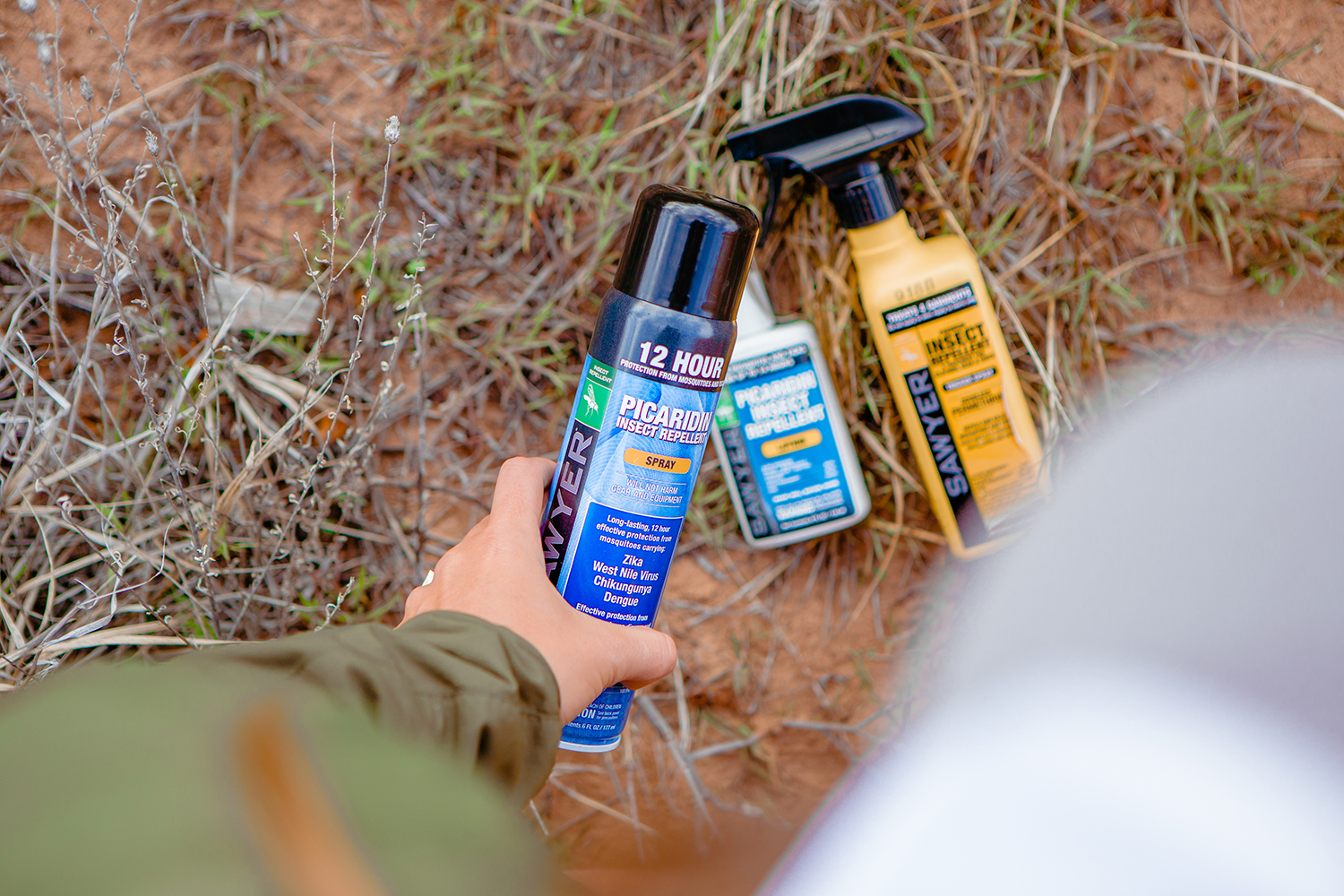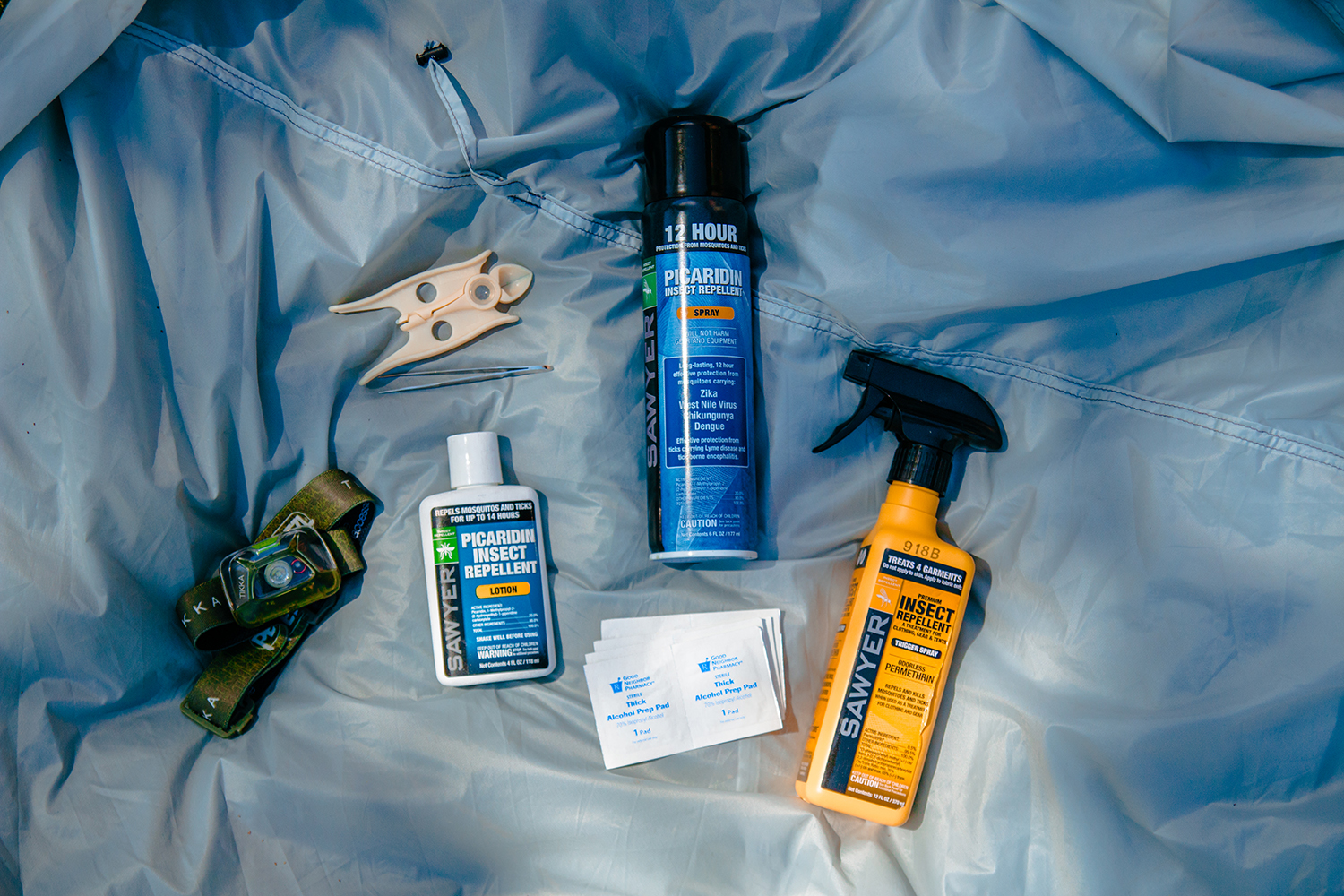Preventing Tick Bites

Preventing Tick Bites
In Partnership with Sawyer
By Laura Hughes
No matter what we’re doing in the outdoors, showing up prepared makes us feel more confident, less afraid of the unknowns, and—perhaps obvious but it’s worth stating—better able to take care of ourselves and others.
One aspect of prevention is dealing with bugs, especially ticks. Ticks aren’t something we love spending a good deal of time thinking about, but a lack of preparation when it comes to them can lead to anxiety when going outdoors. Plus, if you’re not prepared, it can also lead to being exposed to serious diseases, like Lyme, should you encounter a tick bite.
There are a few basic practices and pieces of gear to know about when it comes to preventing tick bites, so we did some research and compiled it all here to get you started. Because your adventures might take you to unpredictable places, but preventing tick bites (or knowing how to respond accordingly) is something you can have some control over.

Photo by Gale Straub.
Do all ticks carry Lyme?
First and foremost, not all ticks carry Lyme disease. The Blacklegged Tick, also known as the Deer Tick, is known to carry Lyme-causing bacteria. That said, it’s important to know that not all Blacklegged Ticks carry Lyme, so just because you are bitten by a tick, or bitten by a Blacklegged Tick, does not automatically mean you were exposed to Lyme Disease.
However, because preventing tick bites is the best way to avoid contracting Lyme or other tick-born diseases, below are some basics for how to be prepared this season.
Preventing Tick Bites: Basic Tips
Wear repellent: If you’re going outdoors, you will want to consider wearing a spray repellent that addresses ticks and other insects. While DEET has been a popular go-to active ingredient for decades, it can be rough on your skin, clothes, and gear. Fortunately, there are alternatives that work just as well if not better, like picaridin (pick-air-eh-den), an ingredient derived from peppers. Our team has tested Sawyer’s Picaridin Insect Repellent in a variety of climates and feel safe wearing it while on the trails.
- Applying Sawyer’s Picaridin Lotion. Photo by Gale Straub.
- Sawyer’s Picaridin Spray. Photo by Gale Straub.
Treat your gear: In addition to treating your skin, you can treat your gear and clothing to make it less hospitable to ticks. The active ingredient in this type of spray is permethrin (per-meth-ren) and once applied, it can be effective for 6 weeks or 6 washings. Sawyer’s Permethrin Spray is easy to use, odorless, and safe for dogs—which makes it a go-to in our book.
Editor’s note: Although used commonly in tick prevention spot treatment, collars, and sprays, Permethrin can be toxic to animals before it has dried, so be careful using Permethrin around pets—especially cats. Cats are more sensitive to Permethrin than other mammals. Cats should never be exposed to Permethrin Pet Sprays, but gear spray doesn’t pose as large a risk since the solution is more diluted. According to a report by the New York Times, “If you are spraying a 1% concentration on clothing and it dries, it’s unlikely that you’ll see any problems with the cat.” Sawyer’s Permethrin Spray for clothing and gear is only 0.5% Permethrin.

It’s good to feel prepared. Treat your gear and clothes at home with Sawyer’s Premetherin Spray before your next adventure. Photo by Laura Hughes.
Consider your attire: Ticks can show up as translucent in earlier stages of development, but are generally dark brown, red, or black in color. Wearing light-colored clothing could help you to identify them easier. However, some research shows that ticks seem to be more attracted to light clothing. So although wearing a dark color will make ticks harder to spot on you, deeper shades tend to attract fewer ticks. Whatever colors you choose to wear, it’s good to consider tucking in your clothes when in a tick-prone area (shirt into pants, pants into socks—there’s no shame in preventing tick bites!).
Stay on trail: Not only is staying on established trails good for the environment, but defined trails generally have less overgrowth, meaning that you’ll be exposed to less ticks.
Do a full body tick check: It’s recommended to check for ticks at least once daily—more if you’re going outside multiple times per day. Ticks don’t fly or jump, but they do like the naturally warmer areas of your body like your armpits, belly button, behind your ears, in your hairline, in the crooks of your knees and elbows, and between your legs. They can be as small as a poppyseed, so a buddy and a magnifying glass might both be helpful for your scans!
If you take your pets outdoors with you, make sure to check your pets for ticks, too. People can often get tick bites because they forget to check their furry friends!
Shower sooner: Research has shown that taking a shower within 2 hours of coming home drastically helps reduce your chance of tick bites. Taking this approach will also make sure ticks don’t linger in your home, vehicle, or anywhere else you’ve been eating your post-hike meal.
Heat treat your clothing: Research has also shown that ticks will not survive in the dry air of a clothing dryer, so when you get home from a tick-thick environment, pop your clothing into a dryer for at least 10 minutes (possibly longer if they started out wet).
Tick Bite Prevention Pack List
Just as you would pack a First Aid Kit, water, and your favorite snacks in your day pack, bringing the proper tick bite prevention gear will help you to focus more on enjoying your time outside. After doing some research, here’s what we recommend bringing with you:
- Bug Spray – with active ingredients like picaridin
- Permethrin Spray – for your clothes, gear, and dog
- Fine Point Tweezers or Tick Pliers – in case a removal is needed
- Magnifying glass – because ticks can be tiny
- Headlamp – because you might do a tick check at night
- Antiseptic Wipes – to clean the skin after a potential tick removal

It doesn’t take much extra space in your bag to show up prepared. Photo by Laura Hughes.
Preventing Tick Bites for Travelers
Some ticks thrive in certain environments better than others. Before you travel to a new region, especially one you are less familiar with, consider checking out what ticks might be prevalent there so you know what to look for.
A simple online search can generally be helpful. For instance, we found this handy map from the Center for Disease Control (CDC) showing the geographic distribution of ticks in the United States.
Preventing Tick Bites for Backyard Adventures
It can be easy to overlook ticks in (literally) your own backyard. If you live in a tick-prone region or have a decent amount of vegetation in and around your property, you might want to consider creating a tick-safe zone, which is a strategic natural barrier that you can create in your yard.
How to Respond to a Tick Bite
Part of showing up prepared is knowing how to manage a tick bite. If you or someone you’re with does get bit by a tick, here are a few tips we found to safely address the situation:
- Remain calm.
- Using fine point tweezers or a tick pliers, pinch the tick as close to the skin as possible.
- Apply even pressure, pulling straight up and minimizing twisting.
- Treat the affected area and your hands with an antiseptic wipe until you can wash thoroughly.
Remember that a tick bite does not equate to contracting a tick-born disease. In fact, the sooner you find and extract the tick, the better chance you have of preventing diseases like Lyme. That said, following a tick bite, you should remain cognizant of possible symptoms and call a doctor if you have unusual symptoms—especially rash, a bull’s eye marking around the bite area, or fever.
Lyme Resources
For those wanting to learn more about the research, support, and communities for those with Lyme Disease, consider starting with (and supporting) the following:
International Lyme and Associated Diseases Society
American Lyme Disease Foundation
Editor’s note: This piece is sponsored by Sawyer and our opinions are all our own. The photos above feature Sawyer’s Picaridin Insect Repellent, Permethrin Spray, and Tick Pliers. Check out their full product collection here.
How do you prevent insect and tick bites?


Where I grew up in Mexico, we use heat to make the tick release itself from your skin. Otherwise, when you remove the tick part of it remains in your skin and you’ll be more than itchy for days. A good trick is to pour wax from a candle onto the tick and the heat from it will make the tick let go of you – you can then remove everything all together. Other people use literally fire from matches or a lighter to achieve this. You must be extremely careful to not burn yourself.
I’ve never heard of tick repellent so I’m excited to give these products a try. Thanks for sharing!
[…] Preventing Tick Bites – Basic Practices and Useful Gear […]